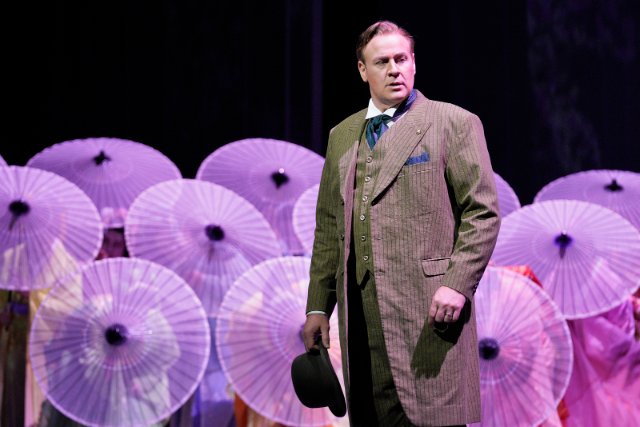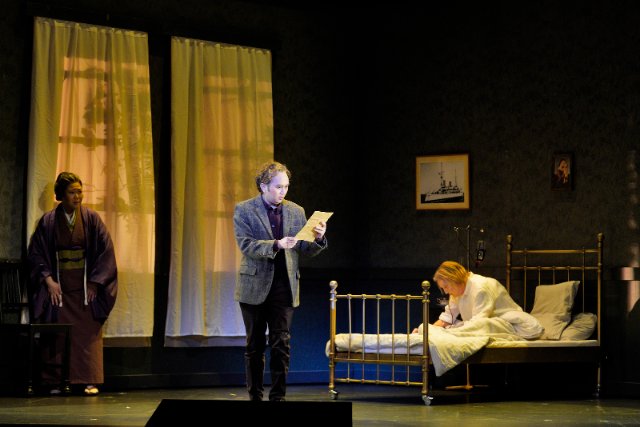Madame Butterfly
At War Memorial Opera House San Francisco
By: Victor Cordell - Jun 08, 2023
With the premiere of “Madame Butterfly” in 1904, Giacomo Puccini would not have realized the enviable hat-trick he had accomplished. Each of three straight operas he had composed would become among the most performed in the world’s opera repertory to this day, over a century later. Uniquely, both Giuseppe Giacosa and Luigi Illica contributed to each of the librettos, comprising a team along with Puccini of uncommon complementary skills.
Musically, “Madame Butterfly” marks a culmination. The first of the three masterpieces, “La Bohème,” is sans pareil in its melodiousness and lyricism. Then comes “Tosca,” perhaps the most noted full-length verismo opera. But despite its harshness and the grim deaths of all four lead characters, it too is replete with memorable, if often dark, music. Finally, “Madame Butterfly” integrates the best of the other two and overlays pentatonic scale Japanese folk melodies to add a whole new dimension to the score. The popularity of this beautiful and exotic wonder should be no surprise.
Although the narrative is simple, the character evolution is profound. Lieutenant B. F. Pinkerton of the U.S. Navy takes the 15-year-old Cio-Cio-San as a port bride, which modern society would consider particularly despicable. He later departs, saying that he would return before the robins nest again, knowing that to be a lie. He does return three years later with his American wife to find that he has a son. In the end, but too late, he shows remorse and responsibility. Despite her delusions about her husband, Cio-Cio-San has grown and realizes the fate she faces with the dishonor of Pinkerton’s behavior.
The key to San Francisco Opera’s wonderous production is a cast headed by four powerful singers. Of course, the opera belongs to Cio-Cio-San, the Butterfly. And while a butterfly may be fragile, singing this part is not for a delicate soprano. Except for the very beginning, she is on stage and the dominant singer throughout, and sometimes singing at full tilt. The fact that Karah Son’s bio lists 15 past and upcoming productions in this role indicates how well it suits her lyricism, power, and range. She handled the signature aria, “Un bel di vedremo,” (“A good day will come”) with grace and elegance. Another memorable moment (actually, 14 minutes) was her extended duets with Pinkerton, “Viena la sera” (“Evening comes”) and “Bimba dagli occhi pieni di malia” (“Girl with malicious eyes”). She did seem to vocally stumble a bit early in the sequence, but it was of little consequence, as she gloriously soared in mellifluous harmony with her loved one to high “c” at the end of the beautiful sequence.
Because of Pinkerton’s lack of empathy for the consequences of his actions toward the impoverished and naïve Cio-Cio-San, his character is loathsome, which makes it hard to cheer for the artist who portrays him. But Michael Fabiano is one of the distinguished tenors of his generation with an agile and penetrating voice. His vocals are commanding from the reckless “Dovunque al mundo” (“Wherever in the world”) to the wistful “Addio fiorito azil” (“Farewell, flowered home”). On occasion, his attention to dynamics does result in a loss of audibility, not that he is incapable of being heard.
Cio-Cio-San’s maid and mother figure is Suzuki, who is played flawlessly by Hyona Kim. She particularly shines in the flower duet with Butterfly and in a brief solo in a Japanese folk idiom. Lucas Meachem is vocally powerful and nicely portrays the internal conflict that Sharpless, the American Consul faces, trying to balance his responsibility to his countryman and his concern for the welfare of a vulnerable young woman.
Puccini would be shocked at the staging of this joint production. It is an adventuresome and thoughtful conceit by Director Amon Miyamoto, which many patrons will love, while some will find distracting and inappropriate. Generally, directors can take the latitude to color a production as they wish as long as they don’t change music or lyrics. This rendition plays as a flashback, seen through the eyes of the young adult son, Trouble, who was raised by Pinkerton and his American wife. In mute scenes as his father lays dying, Trouble reads letters which tell him about his biological mother. He appears as a silent observer throughout the opera, sometimes lurking in the shadows, and other times flailing about like an impotent ghost trying to change the arc of history. Although I was dubious about this device to begin with, I accepted its dramatic validity and impact in the end.
Debate will also extend to the overall production design of the opera. Those who crave grand sets will find this one spare (Boris Kudlicka designer). For most of the opera, the only set piece is symbolic of Cio-Cio-San’s house, represented as a light wood colored, cube-shape with different cutouts on each side. Yet, this minimalism in conjunction with striking projections (Bartek Macias designer), sheer curtains, and sharp costumery (Kenzo Takada designer) reveals visually appealing angularity and a remarkable overall effect.
For those attendees seeing their first “Madame Butterfly” there will be no comparison possible. For those who have seen several, this vision offers something fresh and diverting that will add to the opera goer's experience.
“Madame Butterfly,” composed by Giacomo Puccini with libretto by Giuseppe Giacosa and Luigi Illica, and based on the play of the same name by David Belasco, is produced by San Francisco Opera, Tokyo Nikikai Opera Foundation, Semperoper Dresden, and Royal Danish Opera and plays at War Memorial Opera House, 301 Van Ness Ave., San Francisco, CA through July 1, 2023.








